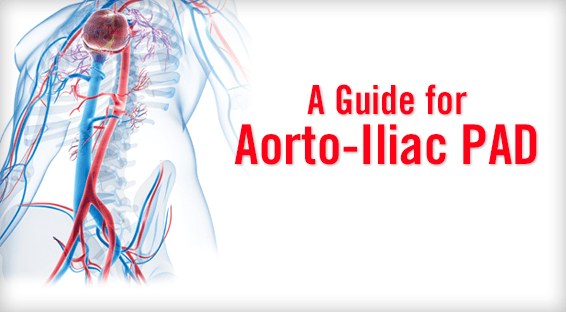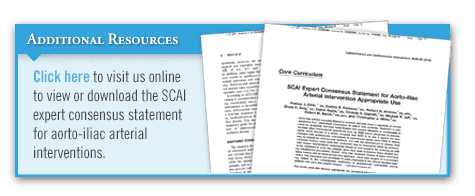Aorto-iliac peripheral arterial disease (PAD) is a serious condition in which blood flow to the lower extremities is blocked by atherosclerotic plaque. These blockages can significantly reduce patients’ quality of life (QOL) by limiting blood flow to the legs, causing pain with walking and, in rare cases, causing limb loss. “Aorto-iliac arterial occlusive disease is common and may cause a spectrum of chronic symptoms, ranging from intermittent claudication to critical limb ischemia,” explains Andrew J. P. Klein, MD, FACC, FSCAI.
Helpful Guidance
The American College of Cardiology and American Heart Association (ACC/AHA) published guidelines that recommend aorto-iliac interventions in patients with lifestyle limiting claudication where the risk-benefit ratio of the intervention is favorable. These guidelines note that endovascular intervention may be considered as a first-line treatment before or in addition to medical therapy and exercise in select cases of aorto-iliac occlusive disease due to its high success rates.
In 2014, the Society for Cardiovascular Angiography and Interventions (SCAI) issued new anatomic, clinical, and technical guidance for the treatment of aorto-iliac PAD. The consensus paper—published in Catheterization and Cardiovascular Interventions—builds on the existing ACC/AHA guidelines for treating PAD. It is the first in a series of recommendations developed by SCAI to address PAD. The other parts of the series address femoropopliteal and infrapopliteal PAD as well as renal artery stenosis.
“This consensus is a first stake in the ground to specifically address the treatment of aorto-iliac PAD with regards to what is appropriate, what may be appropriate, and what is rarely appropriate,” says Dr. Klein, who was lead author of the SCAI consensus paper (Table 1). The document was developed as a contemporary guide for physicians in the practical application of endovascular intervention for aorto-iliac PAD.
Effective Strategies
According to the SCAI consensus paper, medication and walking programs are recommended first-line treatments for aorto-iliac PAD. Endovascular aorto-iliac interventions have emerged as an effective treatment approach to aorto-iliac PAD, with clinical success rates exceeding 90% and a decrease in in-hospital mortality rates (Table 2). “Endovascular interventions are recommended when lifestyle and medication approaches no longer effectively control symptoms and when patient QOL is impacted,” Dr. Klein says.
Several types of surgical bypass procedures have also been shown to improve QOL and relieve symptoms, including aortofemoral bypass, iliofemoral bypass, and aorto-iliac endarterectomy. These procedures have had acceptable mid- and long-term patency rates, but they are also associated with significant surgical risks. “Treating aorto-iliac blockages with open surgery should be used as the last approach due to the surgical risks and the requirement for an inpatient hospital stay,” says Dr. Klein.
Important Considerations
The SCAI paper notes that endovascular treatments can also be used occasionally to facilitate other interventional procedures, such as trans-aortic valve replacement and/or placement of hemodynamic assist devices. In addition, experts reviewed other important aspects of managing aorto-iliac PAD. These included strategies for vascular access; use of antiplatelet therapies; angioplasty and stenting, including stent selection; hybrid procedures; and management of potential complications.
For aorto-iliac PAD involving the common femoral artery and in cases in which multiple levels of the disease need to be addressed, hybrid surgical procedures may be considered. These involve an open surgical procedure followed by stenting in patients with multiple blockages. SCAI notes that interventional cardiologists should be well versed in the anatomy and treatments for aorto-iliac PAD because they will likely need to traverse these vessels during procedures. The ACC/AHA guidelines recommend stenting as the preferred approach for patients with aorta-iliac occlusive disease. Several types of stents are available, but the SCAI paper notes that clinical evidence does not support one type over another at this time.
Experience Counts
It is widely accepted that Trans-Atlantic Inter-Society Consensus (TASC) A, B, and C lesions are best managed with endovascular interventions, but Dr. Klein says that physician experience with managing aorto-iliac PAD is critical. “In experienced hands, most TASC D lesions may be treated by endovascular methods,” he says. Furthermore, with the development of chronic total occlusion devices, many aorto-iliac occlusions may be safely recanalized with endovascular approaches.
Plans are underway to revisit the SCAI consensus paper within the next few years as more evidence emerges. “We anticipate more outcomes-based research that looks at long-term results with endovascular procedures as well as patency and QOL,” Dr. Klein says. “Larger scale studies, randomized control trials, and head-to-head comparisons are also needed so that we can homogenize data and develop a framework to appropriately select patients for treatments that are the safest and most effective.”




 TimH
TimH